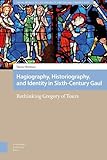Hagiography, Historiography, and Identity in Sixth-Century Gaul : Rethinking Gregory of Tours / Tamar Rotman.
Material type: TextSeries: Social worlds of late antiquity and the early Middle Ages ; 11Publisher: Amsterdam : Amsterdam University Press, [2021]Copyright date: ©2021Description: 1 online resource (196 p.)Content type:
TextSeries: Social worlds of late antiquity and the early Middle Ages ; 11Publisher: Amsterdam : Amsterdam University Press, [2021]Copyright date: ©2021Description: 1 online resource (196 p.)Content type: - 9789048551996
- Christian saints -- Cult -- History -- To 1500
- Historians -- France
- Merovingians -- Historiography
- Middle Ages
- Antiquity
- European history: medieval period, middle ages
- European history: the Celts
- European history: the Romans
- History, Art History, and Archaeology
- Medieval Studies
- HISTORY / Ancient / Rome
- Hagiography, Identity, Merovingians, Ecclesiastical History, Cults of Saints, Early Middle Ages
- 940.1
- D900
- online - DeGruyter
| Item type | Current library | Call number | URL | Status | Notes | Barcode | |
|---|---|---|---|---|---|---|---|
 eBook
eBook
|
Biblioteca "Angelicum" Pont. Univ. S.Tommaso d'Aquino Nuvola online | online - DeGruyter (Browse shelf(Opens below)) | Online access | Not for loan (Accesso limitato) | Accesso per gli utenti autorizzati / Access for authorized users | (dgr)9789048551996 |
Frontmatter -- Social Worlds of Late Antiquity and the Early Middle Ages -- Table of contents -- List of Abbreviations -- Acknowledgments -- Introduction -- 1. Gregory of Tours -- 2. ‘When the Saints Go Marching In’: Eastern Saints in Merovingian Gaul -- 3. The Miraculous History of Gregory of Tours -- 4. ‘By Romans They Refer To…’ (Romanos Enim Vocitant): History, Hagiography, and Identity -- Conclusion -- Bibliography -- Index
restricted access online access with authorization star
http://purl.org/coar/access_right/c_16ec
Gregory of Tours, the sixth-century Merovingian bishop, composed extensive historiographical and hagiographical corpora during the twenty years of his episcopacy in Tours. These works serve as important sources for the cultural, social, political and religious history of Merovingian Gaul. This book focuses on Gregory’s hagiographical collections, especially the Glory of the Martyrs, Glory of the Confessors, and Life of the Fathers, which contain accounts of saints and their miracles from across the Mediterranean world. It analyses these accounts from literary and historical perspectives, examining them through the lens of relations between the Merovingians and their Mediterranean counterparts, and contextualizing them within the identity crisis that followed the disintegration of the Roman world. This approach leads to groundbreaking conclusions about Gregory’s hagiographies, which this study argues were designed as an “ecclesiastical history” (of the Merovingian Church) that enabled him to craft a specific Gallo-Christian identity for his audience.
Mode of access: Internet via World Wide Web.
In English.
Description based on online resource; title from PDF title page (publisher's Web site, viewed 01. Dez 2022)


